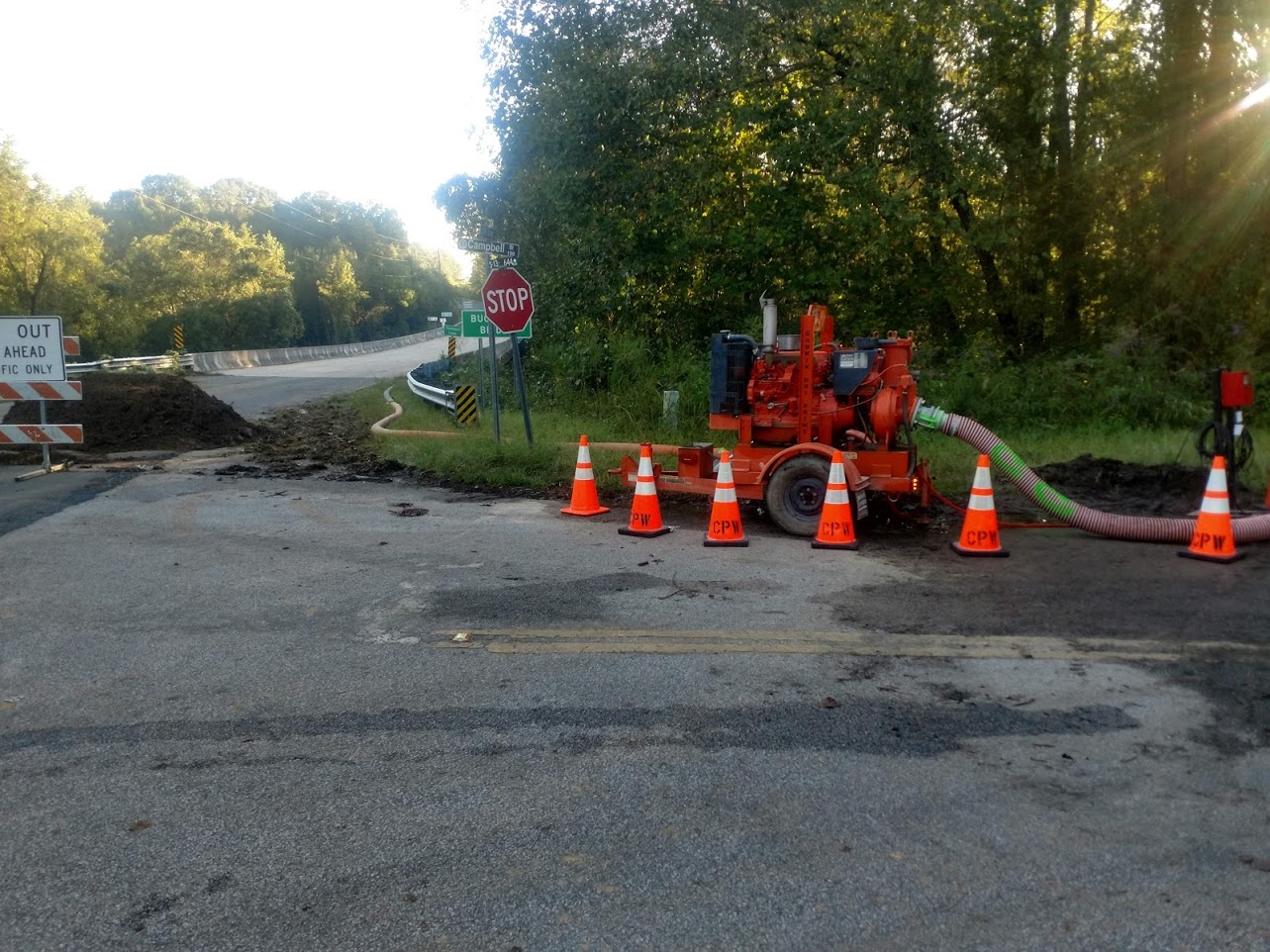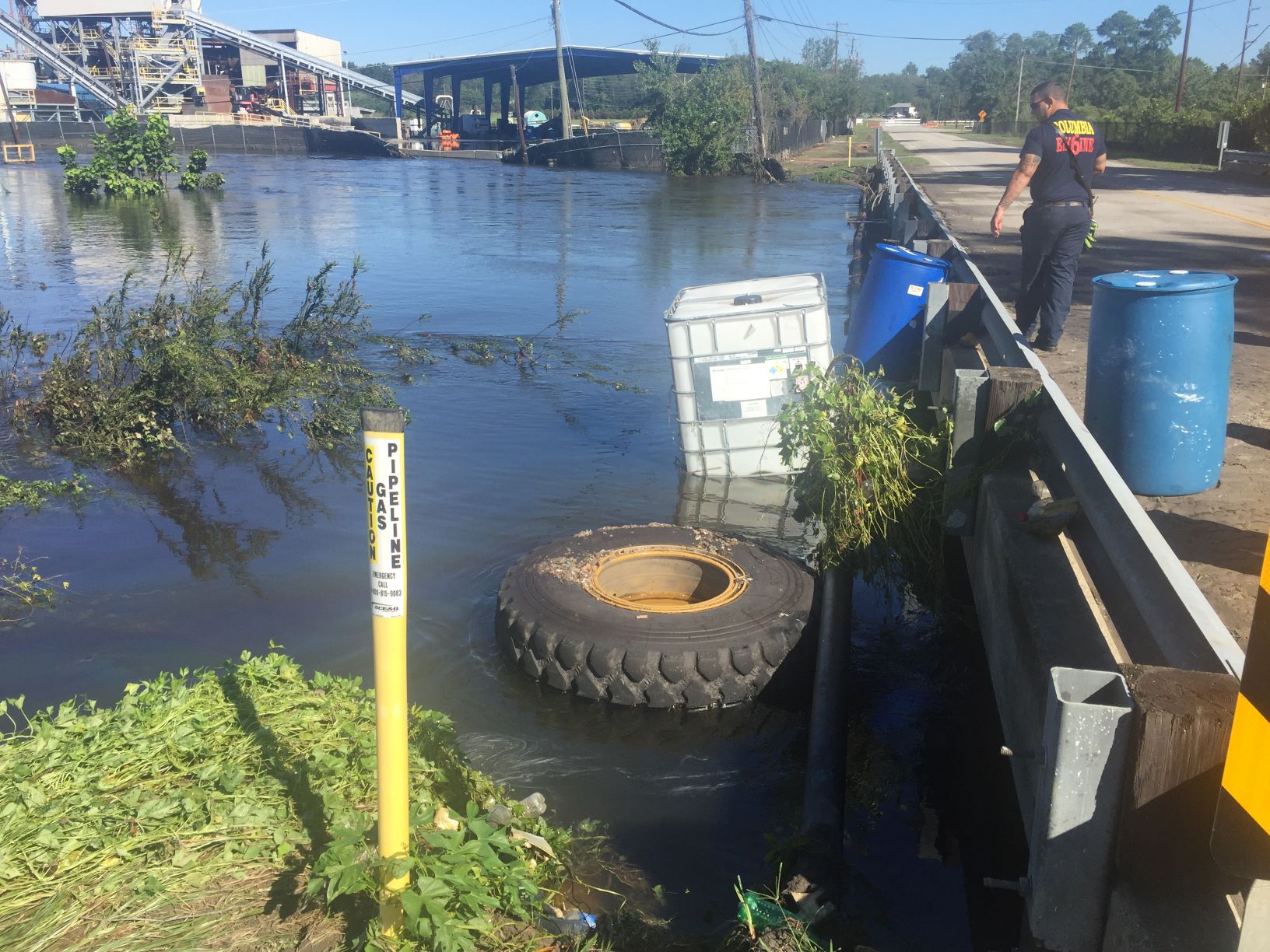Chesterfield Administrator David Huntley knew his town was in trouble soon after the flooding from Hurricane Florence began. A 12-inch sewer line covering a 700-foot span above a creek was wiped out, dropping raw sewage and rainwater into a swollen waterway already raging with flood waters.

The City of Camden came to the aid of the Town of Chesterfield with a
bypass pump when flooding washed out a 12-inch sewer line.
"We're a small town. We had no way of coming up with a temporary fix, much less figure out how to fix it permanently," he said.
Luckily for Chesterfield, and for many other coastal and Pee Dee towns swamped by the September hurricane, help came quickly from other South Carolina municipalities, eager to jump in and offer assistance.
In Chesterfield, Rep. Richie Yow got on the phone with Sen. Vincent Sheheen of nearby Camden. By midnight, the City of Camden had a bypass pump in place and 700 feet of 6-inch pipe laid across the side of the bridge in Chesterfield.
"Without the City of Camden, I'm not sure what we'd be doing," Huntley said. "It took probably 12 hours from the time we knew the sewer line washed out until Camden was there. DHEC was extremely happy we could get a temporary fix in place."
Chesterfield also received help from the City of Lancaster with picking up mountains of yard debris, with work coordinated through the Municipal Association. Instead of Chesterfield town workers manually picking up debris and tossing it in a dump truck, Lancaster sent a crew of four workers and two knuckle boom trucks with claws that quickly and easily cleared piles of yard debris.
"They could do more in a day than we could have done in three weeks," Huntley said.
Steven "Flip" Hutfles, Lancaster city administrator, said his staff and crews understand the needs of municipalities in the wake of powerful storms. When Hurricane Matthew flooded the state in 2016, Lancaster workers helped out in Latta for two weeks.
"We have some seasoned veterans who were here when Hugo hit. Lancaster was hit very hard by Hugo in 1989. It's still fresh in a lot of employees' minds. They can feel for someone else," Hutfles said. "If they can come back and pay it forward, we're more than happy to."
City staff in Columbia feel the same way, with the memories of the historic floods that hit the capital city in 2015 still vivid in workers' minds.
As Hurricane Florence approached, the Columbia Fire Department's medical emergency response vehicle made three trips to the coast with drivers, navigators and medical personnel. There, they evacuated people from medical facilities in cities and towns in Georgetown and Horry counties, moving them to health care facilities around the state, said Columbia Fire Department Chief of Special Operations Daniel McManus.

Through the South Carolina firefighter mobilization and mutual aid program, the City of Columbia Fire Department assisted the City of Hartsville and several other cities after Hurricane Florence.
After the storm, the Hartsville Fire Department, through the South Carolina firefighter mobilization and mutual aid program, requested two engine companies to relieve firefighters who had been working excessive hours, McManus said. The statewide program encourages overstrained departments to request help from other cities. Columbia responded, sending two engines and a battalion chief to relieve the Hartsville firefighters for 24 hours.
Then Columbia firefighters headed to the coast with a 15-member water rescue team and four boats deployed to the Pawleys Island and Litchfield Beach area. Along with City of Charleston teams, they conducted search and rescue missions. The help from the two cities allowed the area fire department to expand its coverage from three boats to 12. After 16-hour workdays, helping check on residents by boat, the team moved about 20 miles to the Conway area, which was facing devastating flooding.
"We got to Conway and found homes under 5 to 8 feet of water. The teams were deployed for 18 hours, and 2,800 homes were assessed. We made contact with over 200 residents," McManus said. The Columbia Fire team was also able to use a new FEMA app that allowed them to take photos of homes and detail the type of damage each sustained, enabling the incident command station to see the extent of the flooding damage in real time.
Other cities and towns also pitched in to help their fellow South Carolinians. The City of Simpsonville organized a donation drive, with a tractor trailer set up in a church parking lot across from the fire department.
Firefighters and police officers manned the truck 12 hours a day for three days, until it was filled with supplies — everything from canned food and toothpaste to toilet paper and diapers. The truck carried supplies to Horry County Fire Station No. 7 near Myrtle Beach.
"I could not be happier that the City of Simpsonville was able to do our part in helping our friends on the coast. Providing donated food, diapers and bottled water is the least we could do. Although I was impressed by our residents and citizens, I was not surprised. This drive was an example of how giving our city is, and it's important we take every opportunity we can to give to those in need," Mayor Janice Curtis said.
The City of Westminster also collected trucks full of supplies. Mayor Brian Ramey said his work with the South Carolina Baptist Convention's disaster relief team helped him understand the need for supplies following a storm.
After the city put the word out, dozens of people came in to the Westminster fire station with cases of bottled water and personal supplies.
Ramey learned from the Municipal Association that Mullins Mayor Bo McMillan had put out a call for help for the Town of Nichols. The city then pooled its collections with an area church and a local business, and sent its first two shipments — including a 10,000-pound load of water and supplies — to Mullins and Nichols. A later collection went to the Georgetown area.
"We've got a great group of people up here. We know we're far enough away that hurricanes don't affect us, but we wanted to help," Ramey said.
McMillan said help from Westminster, Easley and other towns were part of the acts of kindness "that makes you enormously proud, No. 1, to be a South Carolinian, and No. 2, a mayor of a South Carolina town. We're South Carolina strong, indeed we are. What I have seen in the last three weeks and what I saw two years ago were wonderful acts of love."
The state's network of Main Street cities also reached out to help storm-damaged downtown businesses. Jenny Boulware, manager for Main Street SC, said she learned Dillon needed large, industrial-grade fans to dry out flooded downtown businesses.
She contacted the state's Main Street communities, which almost immediately stepped in to help, and Boulware requested the fans for Dillon. One of those Main Street programs that answered the call was Summerville DREAM.

The state's network of Main Street cities stepped up to help storm-damaged downtown businesses, such as This That & More in downtown Dillon, with industrial-grade fans to dry out flooded downtown businesses in Dillon. Photo: City of Dillon.
"The impact of the downtown commercial district on the local economy is significant. When the commercial district is threatened by natural disaster, it's important for friends and neighbors to lend a hand — if possible, to mitigate the effects; if not, to help with clean up and restoration. We were honored to be able to offer assistance to our colleagues in Dillon and we're pleased to know that they are recovering from Florence's impact," said Michael Lisle, executive director of Summerville DREAM.
Edisto Beach Mayor Jane Darby, who is the president of the Association of South Carolina Mayors, said she remembers the winds and rain of Hurricanes Joaquin, Matthew and Irma. That's why she doesn't hesitate to respond to any South Carolina town in need during a storm.
"During those times, it is extremely stressful and it is reassuring to have other mayors and other towns reaching out to you and asking what they can do. They assure you that you have their support. It's a wonderful, collegial feeling. This year, we were most fortunate, we were not impacted by Florence. However, some of our other mayors were. We made an effort to reach out to them and offer the same support they've given to us before," she said.
Darby knows how exhausting the days before, during and in the aftermath of a storm can be for city leaders and employees. She also knows the importance of cities reach out and helping each other.
"After Matthew, we sent a planning department [person] to Nichols to do appraisals and assessments. They're a small town, which we can relate to. None of us have all the resources," she said. "The state is very good about supplying what is needed, but often it is not quick enough or timely enough. If you can contact one of the other cities that have that equipment, you can get it immediately."
Darby said the Municipal Association helped work as a clearinghouse, matching cities in need with those willing to help.
"I think events like this, while we don't always agree on issues, bring us together even more because we have been there, done that, and we recognize the need," she said. "I think that's important. We are ready to band together to take care of any need."
